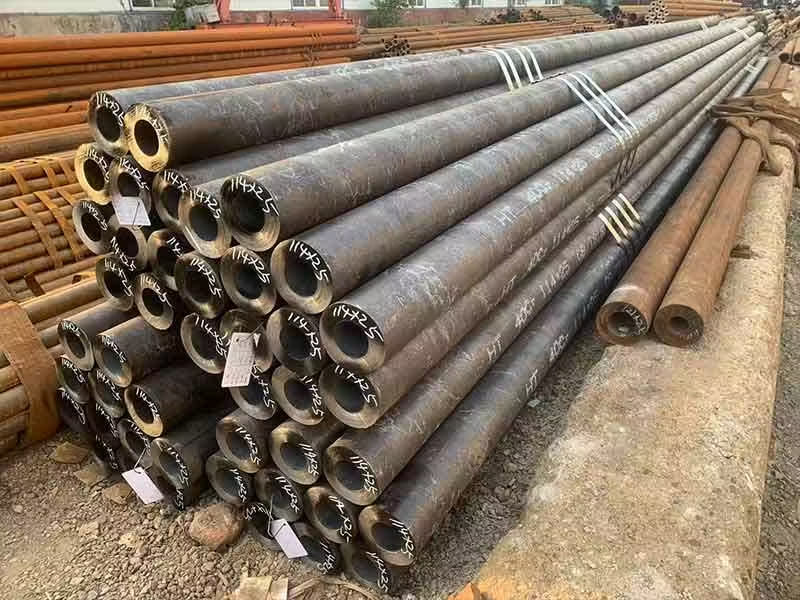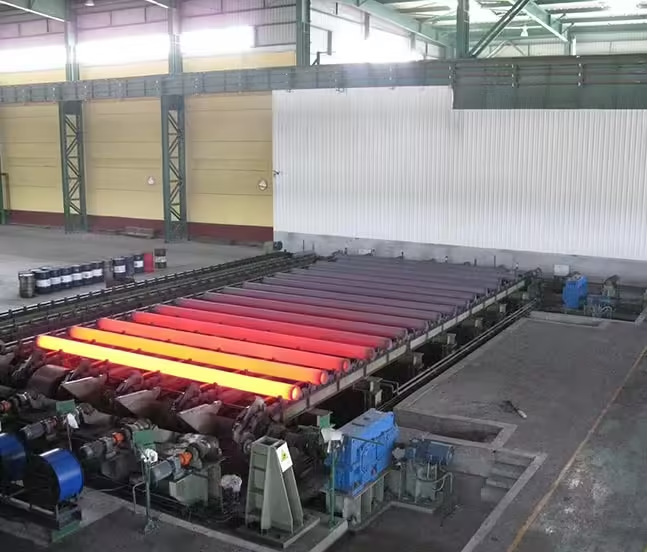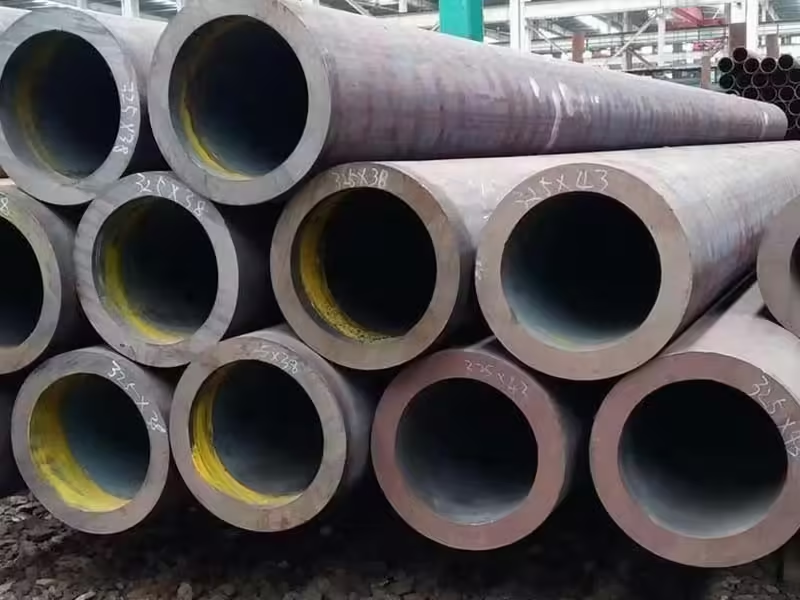내 블로그에 오신 것을 환영합니다!
본론으로 들어가기 전에, 제가 더 많은 정보를 공유하고, 커뮤니티와 소통하고, 업데이트를 게시하는 소셜 미디어 플랫폼에 함께해 주세요. 저와 소통하는 방법은 다음과 같습니다.
페이스북:https://www.facebook.com/profile.php?id=61571539990739
자, 이제 함께 여정을 시작해 볼까요? 여기 있는 내용이 통찰력 있고, 흥미롭고, 가치 있다고 느끼시기를 바랍니다.
목차
소개

심리스 탄소강관은 석유 및 가스, 발전, 제조 산업에서 핵심 부품으로, 강도, 균일성, 그리고 고압 및 고온 내성을 자랑합니다. 용접 파이프와 달리 심리스 파이프는 이음매 없이 제작되어 까다로운 용도에도 탁월한 무결성을 보장합니다. 업계 관계자에 따르면, 탄소강관에 대한 전 세계 수요가 연간 1억 8천만 톤을 초과함에 따라 ASTM A106 및 API 5L과 같은 심리스 파이프는 높은 신뢰성 덕분에 고위험 산업에서 압도적인 우위를 점하고 있습니다.
이 포괄적인 가이드에서는 원활한 탄소강 파이프의 제조, 특성 및 응용 분야를 살펴보고, 엔지니어, 조달 전문가 및 제조업체가 필요에 맞는 올바른 파이프를 선택하여 산업 운영에서 안전성, 효율성 및 내구성을 보장할 수 있도록 비교 표와 FAQ를 제공합니다.
원활한 이해 탄소강 파이프
심리스 탄소강관은 탄소강으로 제작된 원통형 튜브로, 극한 조건에서도 구조적 안전성을 보장하기 위해 용접 없이 생산됩니다. 일반적으로 0.15~1.05%의 탄소와 망간을 함유한 이 파이프는 ASTM A106 및 API 5L과 같은 표준을 충족하며, 높은 인장 강도와 적절한 내식성을 제공합니다. 이 섹션에서는 제조 공정, 재료 특성 및 표준을 살펴보고, Octal Steel 및 Permanent Steel의 통찰력을 바탕으로 산업 시스템에서 심리스 탄소강관의 역할을 이해하는 데 필요한 기반을 제공합니다.
이음매 없는 탄소강관의 제조 공정
심리스 탄소강관은 열간 압연, 냉간 인발 또는 압출을 통해 생산됩니다. 열간 압연에서는 강재를 1200~1300°C로 가열하고 구멍을 뚫어 중공 튜브를 만든 후, 원하는 치수로 압연합니다(Octal Steel). 냉간 인발은 상온에서 다이를 통과시켜 파이프의 표면과 공차를 미세하게 조정하여 더 작은 직경(예: 1/8~6인치)의 정밀도를 향상시킵니다. 복잡한 형상에 사용되는 압출은 Permanent Steel에서 언급했듯이 가열된 강재를 다이를 통과시켜 압연합니다. 이러한 공정은 용접을 제거하여 심리스 탄소강관이 최대 7000psi의 압력을 견딜 수 있도록 하여 송유관과 같은 고응력 용도에 이상적입니다.
이음매 없는 탄소강 파이프의 재료 특성
심리스 탄소강관은 ASTM A106 Gr. B 또는 API 5L X52와 같은 등급에 따라 ASTM 표준에 따라 245~415 MPa의 항복 강도와 415~760 MPa의 인장 강도를 나타냅니다. 탄소 함량(0.15~1.05%)은 강도를 향상시키고, 망간(0.3~1.06%)은 인성을 향상시킵니다. 강관 공급업체에 따르면, 에폭시와 같은 코팅은 습한 환경에서도 수명을 연장하지만, 중간 정도의 내식성은 비산성 환경에 적합합니다. 열전도도(50 W/m·K)와 높은 융점(~1420°C) 덕분에 심리스 탄소강관은 증기 보일러와 같은 고온 응용 분야에 적합하며, 열 응력 하에서도 신뢰성을 보장합니다.
이음매 없는 탄소강 파이프의 표준 및 등급
심리스 탄소강관은 ASTM A106(고온 서비스), ASTM A53(일반 용도), API 5L(석유 및 가스 파이프라인)과 같은 표준을 준수합니다. Octal Steel에 따르면 A106 Gr. B(245MPa 항복강도) 및 API 5L X65(448MPa 항복강도)와 같은 등급은 성능을 정의하며, A106은 발전소에, API 5L은 파이프라인에 적합합니다. Permanent Steel에서 명시한 바와 같이, 규격은 벽 두께(Schedule 10-XXS), 직경(1/8-36인치), 길이(최대 12미터)를 포함하여 산업 시스템과의 호환성을 보장합니다. ASME 및 DIN 표준을 준수하여 심리스 탄소강관 선정에 중요한 글로벌 적용성을 보장합니다.
이음매 없는 탄소강 파이프의 장점
심리스 탄소강관은 용접관에 비해 뛰어난 강도, 균일성 및 내압성을 제공합니다. 강관 공급업체에 따르면, 이음매가 없어 취약한 부분이 없어 고압 시스템에서 파손 위험이 줄어듭니다. 균일한 벽 두께는 석유 및 가스 운송에 필수적인 일관된 흐름을 보장하며, 높은 연성(15-20% 신장률)은 균열 없이 굽힘 가공을 가능하게 한다고 Octal Steel은 강조합니다. 심리스 탄소강관은 -29°C에서 427°C까지의 온도 범위에서 사용 가능한 다재다능함으로 다양한 산업 분야에서 성능과 비용 효율성의 균형을 맞춰 선호됩니다.
이음매 없는 탄소강 파이프 환경에서 용접 파이프와의 비교
용접 파이프에 비해 심리스 탄소강 파이프는 고압 및 고온 환경에서 탁월한 성능을 발휘합니다. 강판을 접합하여 만든 용접 파이프는 응력 발생 시 파손 위험이 있는 이음매가 있으며, Permanent Steel에 따르면 압력 등급이 5~10%로 더 낮습니다. 심리스 파이프는 용접이 없는 표면에서 더 우수한 내식성을 제공하지만, Octal Steel에 따르면 용접 파이프는 급수와 같은 저압 용도에서 더 비용 효율적입니다. 정유 공장과 같은 핵심 용도에서 심리스 탄소강 파이프의 신뢰성은 제조 복잡성을 능가하며, 이는 안전이 중요한 시스템에 적합한 소재 선택의 기준이 됩니다.
이음매 없는 탄소강 파이프의 적용

심리스 탄소강관은 견고하고 고성능의 배관이 필요한 산업에 필수적입니다. 석유 및 가스 파이프라인부터 발전 및 구조용 설비에 이르기까지, 그 강도와 신뢰성은 운영 효율성을 보장합니다. 이 섹션에서는 주요 적용 분야, 성능 지표 및 사례 연구를 살펴보고, 업계 사례를 통해 심리스 탄소강관의 다재다능함을 강조합니다.
석유 및 가스 산업에서의 이음매 없는 탄소강 파이프 적용
무계목 탄소강 파이프는 파이프라인, 시추, 정유에 사용되는 석유 및 가스 분야에서 널리 사용됩니다. API 5L 등급(예: X52, X65)은 원유와 천연가스를 장거리 운송하며, 옥탈 스틸(Octal Steel)에 따르면 최대 5000psi의 압력을 견디고 토양 부식에 강합니다. 시추 작업 시 ASTM A106 Gr. B와 같은 무계목 파이프는 케이싱과 튜빙을 형성하며, 퍼머넌트 스틸(Permanent Steel)에 따르면 시추공의 압력과 온도를 견뎌냅니다. 정유 공장은 400°C 미만의 유체 이송에 무계목 파이프를 사용하며, 전 세계 석유 파이프라인의 70%는 누출 없는 성능, 안전성 및 효율성을 위해 무계목 탄소강 파이프를 사용합니다.
이음매 없는 탄소강관을 사용한 발전 및 보일러 시스템
발전 분야에서 무계목 탄소강관은 보일러, 열교환기 및 증기 배관에 매우 중요합니다. ASTM A106 Gr. B 파이프는 427°C 및 3000psi의 증기를 처리하며, 강관 공급업체에 따르면 석탄 및 가스 화력 발전소에서 무결성을 유지합니다. Octal Steel에 따르면, 열전도도가 높아 장시간 열 발생 시 크리프(creep) 현상에 강합니다. 원자력 발전소의 무계목 파이프는 냉각 유체를 운반하며, 보일러 배관의 경우 무계목 탄소강관을 사용하여 신뢰성을 높이고 에너지 생산 시 유지보수 및 가동 중단 시간을 줄입니다.
이음매 없는 탄소강관의 기계적 및 구조적 용도
심리스 탄소강 파이프는 기계 부품 및 비계와 같은 기계 및 구조용 소재로 사용됩니다. ASTM A53 Gr. B 파이프는 중장비의 샤프트와 롤러를 형성하며, Permanent Steel 규격에 따라 높은 인장 강도(415 MPa)를 발휘합니다. 건설 현장에서 심리스 파이프는 임시 구조물이나 유압 시스템을 지지하며, Octal Steel에서 언급했듯이 굽힘 및 절단 시 균일한 강도를 제공합니다. 고강도 파이프의 심리스 파이프가 사용되는 자동차 섀시 및 크레인 암에 심리스 파이프를 사용하면 동적 하중에 대한 내구성이 보장되어 다재다능한 구조재로 활용할 수 있습니다.
이음매 없는 탄소강 파이프의 화학 및 석유화학 응용 분야
화학 및 석유화학 공장에서 심리스 탄소강 파이프는 산이나 탄화수소와 같은 유체를 운반합니다. ASTM A106 파이프는 에폭시 코팅 처리되어 경미한 화학적 부식에 강하며, Steel Pipe Supplier에 따르면 최대 4000psi의 압력을 견딜 수 있습니다. Permanent Steel에 따르면, 심리스 설계는 암모니아 생산과 같은 고위험 공정에서 누출을 최소화합니다. 심리스 파이프는 정유 공장에서 사용되는 배관의 65%를 차지하며, 균일한 벽은 안전한 유체 흐름을 보장하므로 심리스 탄소강 파이프는 공정 안전 및 운영 연속성 유지에 필수적입니다.
이음매 없는 탄소강관의 제작 및 유지관리
심리스 탄소강관 제작에는 시스템 요건을 충족하기 위한 절단, 용접, 나사산 가공이 포함됩니다. Octal Steel에 따르면, 파이프는 견고한 접합을 위해 MIG 또는 TIG 용접을 사용하며, 균열 방지를 위해 150°C로 예열합니다. 유지보수에는 특히 습한 환경에서의 피팅(pitting) 정기 검사와 Permanent Steel에 따르면 3LPE와 같은 코팅을 적용하여 수명을 5~10년 연장하는 것이 포함됩니다. 스케일 제거제를 사용하여 세척하면 내부 침전물이 제거되어 유동 효율이 향상됩니다. 적절한 제작 및 유지보수는 심리스 탄소강관의 수명을 연장하여 장기적인 산업 성능을 보장합니다.
이음매 없는 탄소강 파이프에 대한 비교표 및 성능 통찰력
이음매 없는 탄소강 파이프의 용도를 명확히 하기 위해 다음 표에서는 일반적인 등급, 특성, 용도를 비교하여 전문가에게 참고 자료를 제공합니다.
| 등급 | 주요 속성 | 응용 프로그램 |
|---|---|---|
| ASTM A106 Gr. B | 항복강도 245MPa, 인장강도 415MPa, 최대 427°C | 보일러, 정유소, 증기관 |
| API 5L X52 | 360MPa 항복강도, 460MPa 인장강도, 높은 인성 | 석유 및 가스 파이프라인, 시추 |
| ASTM A53 Gr. B | 240MPa 항복강도, 415MPa 인장강도, 일반용 | 구조, 수상 운송, 기계 |
| API 5L X65 | 448MPa 항복강도, 535MPa 인장강도, 고강도 | 장거리 가스 파이프라인 |
| ASTM A179 | 180MPa 수율, 저탄소, 열교환기 사용 | 열교환기, 응축기 |
이음매 없는 탄소강 파이프에 대한 성능 통찰력
이 표는 심리스 탄소강관의 다재다능함을 보여줍니다. ASTM A106 Gr. B는 보일러와 같은 고온 용도에 적합하며, Octal Steel에 따르면 427°C에서 안정적인 성능을 제공합니다. API 5L X52 및 X65는 Permanent Steel에 따르면 긴 파이프라인에 대한 강도가 높아 석유 및 가스에 최적화되어 있습니다. ASTM A53 Gr. B는 일반 용도 및 구조용에 적합하며, Steel Pipe Supplier에 따르면 A179의 저탄소 조성은 열교환기에 이상적입니다. 압력, 온도 및 환경 조건에 따라 선택이 달라지므로 심리스 탄소강관은 특정 작동 요건을 충족합니다.
이음매 없는 탄소강관 선정 전략
심리스 탄소강관을 선택하려면 적용 요건을 평가해야 합니다. 고온 보일러의 경우 ASTM A106 Gr. B를 선택하고, 송유관의 경우 Octal Steel의 권고에 따라 API 5L X65가 우수한 강도를 제공합니다. Permanent Steel 규격에 따라 벽 두께(중압은 Schedule 40, 고압은 Schedule 80)와 유량 요구 사항에 따른 직경을 고려하십시오. ASTM 또는 API 표준을 준수하는지 확인하고, 품질 보증을 위해 Steel Pipe Supplier와 같은 인증된 공급업체에서 제품을 공급받으십시오. 파이프 표면 결함을 검사하고 부식성 환경에 적합한 코팅을 적용하여 심리스 탄소강관의 성능과 수명을 최적화하십시오.
이음매 없는 탄소강 파이프에 대한 실제 고려 사항

심리스 탄소강 파이프를 효과적으로 사용하려면 전략적 선정, 설치 및 유지 관리가 필요합니다. 이 섹션에서는 전문가가 성능과 내구성을 극대화할 수 있도록 실질적인 지침을 제공합니다.
프로젝트에 적합한 이음매 없는 탄소강 파이프 선택
심리스 탄소강 파이프를 선택하려면 프로젝트 요구 사항에 맞는 등급 및 사양이 필요합니다. 정유 공장의 경우, ASTM A106 Gr. B는 고온 신뢰성을 보장하고, Octal Steel에 따르면 API 5L X52는 석유 운송에 적합합니다. Permanent Steel에서 명시한 바와 같이 유량 및 압력에 따라 직경(1/8~36인치)과 일정(10~XXS)을 평가하십시오. 환경 요인(습한 기후에서는 에폭시 코팅 사용)을 고려하고 Steel Pipe Supplier와 같은 공급업체의 인증(예: ASTM A106, API 5L)을 확인하십시오. 엔지니어와 협의하여 피팅 및 밸브와의 호환성을 확인하고 심리스 탄소강 파이프가 시스템 요구 사항을 충족하는지 확인하십시오.
이음매 없는 탄소강관 설치 기술
적절한 설치는 무계목 탄소강관의 성능을 향상시킵니다. Octal Steel에 따라 안정성을 위해 클램프를 사용하여 응력을 방지하기 위해 파이프를 정확하게 정렬하십시오. 저수소 전극을 사용하여 균열을 방지하기 위해 150°C로 예열한 후 용접 접합부를 용접하고, Permanent Steel의 지침에 따라 X선 검사를 통해 용접부의 무결성을 검사하십시오. Steel Pipe Supplier에 따라 5cm 미만의 작은 파이프는 PTFE 테이프로 단단히 밀봉하여 빠른 연결을 보장하십시오. 처짐을 방지하기 위해 1.8~2.5m마다 파이프를 지지하고, 작동 압력의 1.5배에서 압력 테스트를 수행하여 무계목 탄소강관의 누출 없는 작동을 확인하십시오.
이음매 없는 탄소강 파이프의 유지 관리 및 부식 방지
유지보수를 통해 심리스 탄소강관의 수명을 연장할 수 있습니다. Octal Steel에 따라 6~12개월마다 초음파 검사를 통해 벽 두께를 측정하여 부식이나 스케일 발생 여부를 점검하십시오. Permanent Steel에 따르면 3LPE 또는 FBE 코팅을 적용하여 부식을 방지하고 습한 환경에서도 수명을 5~10년 연장할 수 있습니다. 강관 공급업체의 권고에 따라 스케일 제거제로 배관을 세척하여 침전물을 제거하고 흐름 효율을 유지하십시오. 사용하지 않는 배관은 건조하고 덮개가 있는 곳에 보관하여 녹 발생을 방지하고, 아연 함량이 높은 프라이머로 경미한 부식을 보수하여 심리스 탄소강관이 20~30년 동안 안정적으로 유지되도록 하십시오.
이음매 없는 탄소강 파이프를 사용한 스케일링 시스템
배관 시스템 확장에는 심리스 탄소강 파이프를 고급 부품과 통합하는 작업이 포함됩니다. Octal Steel에 따르면, 확장된 파이프라인에는 API 5L X65와 같은 고강도 등급을 사용하십시오. Permanent Steel에 따르면, 압력 및 부식을 모니터링하는 스마트 센서를 통합하여 고장률을 15%까지 줄이십시오. Steel Pipe Supplier에 따라 시스템 유연성을 위해 매니폴드와 밸브를 추가하고, 호환성을 위해 ASTM 등급을 표준화하십시오. 모듈식 설계를 계획하여 코어 배관을 교체하지 않고도 향후 확장이 가능하도록 하고, 심리스 탄소강 파이프가 증가하는 산업 수요를 효율적으로 충족하도록 하십시오.
이음매 없는 탄소강관 사용의 과제
부식, 설치 복잡성, 그리고 재료 선택 등의 어려움이 있습니다. 심리스 탄소강관은 산성 또는 해양 환경에서 녹이 슬기 쉽기 때문에 Octal Steel에 따르면 코팅이 필요합니다. Permanent Steel에 따르면 복잡한 용접 및 정렬은 설치 시간을 증가시키지만, 숙련된 인력을 투입하면 이러한 문제를 완화할 수 있습니다. 고압 시스템의 경우 A53과 같이 잘못된 등급을 선택하면 고장 위험이 있으며, Steel Pipe Supplier에 따르면 컨설팅 표준을 통해 해결해야 합니다. 적절한 코팅, 교육 및 공급업체 지침을 통해 심리스 탄소강관이 까다로운 환경에서도 일관된 성능을 발휘하도록 하여 문제를 해결하십시오.
결론
심리스 탄소강 파이프는 산업 시스템의 초석으로, 석유 및 가스, 발전, 그리고 기계 설비에 탁월한 강도와 신뢰성을 제공합니다. 전문가는 탄소강 파이프의 특성, 등급 및 유지 보수 요구 사항을 이해함으로써 안전성과 효율성을 극대화하여 파이프 사용을 최적화할 수 있습니다.
이 가이드는 표와 FAQ를 통해 심리스 탄소강 파이프를 선택하고 유지 관리하여 장기적인 성능을 보장하는 방법을 안내합니다. FAQ를 통해 배관 프로젝트를 개선하는 데 필요한 심층적인 정보를 얻으세요.
자주 묻는 질문
이음매 없는 탄소강 파이프란 무엇입니까?
이음매 없는 탄소강 파이프는 탄소강으로 만든 용접이 필요 없는 튜브로, 고압 및 고온 용도에 사용됩니다.
이음매 없는 탄소강관의 주요 용도는 무엇입니까?
석유 및 가스 파이프라인, 보일러, 정유소, 구조물 등에 사용되어 안정적인 유체 운반을 보장합니다.
이음매 없는 탄소강관은 어떻게 만들어지나요?
산업 표준에 따라 열간 압연, 냉간 인발 또는 압출을 통해 생산되며, 균일하고 용접이 필요 없는 파이프가 만들어집니다.
용접 파이프 대신 이음매 없는 탄소강 파이프를 선택하는 이유는 무엇입니까?
이음매 없는 파이프는 20%보다 더 높은 압력 저항성과 더 나은 내식성을 제공하므로 중요한 시스템에 이상적입니다.
이음매 없는 탄소강 파이프에는 어떤 등급이 있나요?
일반적인 등급으로는 ASTM A106 Gr. B, API 5L X52, ASTM A53 Gr. B가 있으며, 각각 특정 용도에 맞게 제작됩니다.

